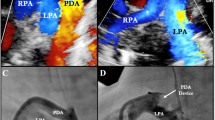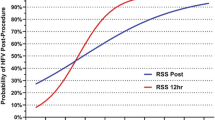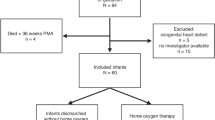Objective
To determine the clinical/echocardiography (ECHO) phenotype of patients with hypoxic respiratory failure (HRF) and response to late surfactant, according to patent ductus arteriosus (PDA) status.
Study design
This retrospective study included infants ≤26+6 weeks gestation who received ≥1 surfactant dose after 6 postnatal days and where PDA status was available by ECHO. Response to surfactant was appraised based on change in respiratory severity score over 48 h. The relationship between PDA status and response to surfactant was evaluated via univariate analysis.
Result
We studied late surfactant (n = 71 doses) administration in 35 preterm infants born at a mean weight and GA at birth were 595 g (508, 696) and 23.3 (22.7, 25) weeks, respectively of whom 16 (46%) had a diagnosis of PDA. Positive response to late surfactant treatment was independently associated with absence of PDA [OR 26 (2, 334), p = 0.01] whereas presence of PDA was independently associated with negative response [OR 12 (1.1, 126), p = 0.04].
Conclusions
In neonates ≤26+6 weeks gestation, with HRF, response to surfactant after postnatal day 6 is influenced by PDA status. Future trials should consider PDA status which may enhance diagnostic precision and refine patient selection for late surfactant treatment.
This is a preview of subscription content, access via your institution
Access options
Subscribe to this journal
Receive 12 print issues and online access
$259.00 per year
only $21.58 per issue
Buy this article
- Purchase on Springer Link
- Instant access to full article PDF
Prices may be subject to local taxes which are calculated during checkout



Similar content being viewed by others
References
Bell EF, Hintz SR, Hansen NI, Bann CM, Wyckoff MH, DeMauro SB, et al. Mortality, In-Hospital Morbidity, Care Practices, and 2-Year Outcomes for Extremely Preterm Infants in the US, 2013-2018. JAMA. 2022;327:248–63.
Jobe AH. Pulmonary surfactant therapy. N. Engl J Med. 1993;328:861–8.
Soll R, Ozek E. Prophylactic protein free synthetic surfactant for preventing morbidity and mortality in preterm infants. Cochrane database Syst Rev. 2010;2010:Cd001079.
Soll RF. Prophylactic synthetic surfactant for preventing morbidity and mortality in preterm infants. Cochrane Database Syst Rev. 2000;2:Cd001079.
Vitali F, Galletti S, Aceti A, Aquilano G, Fabi M, Balducci A, et al. Pilot observational study on haemodynamic changes after surfactant administration in preterm newborns with respiratory distress syndrome. Ital J Pediatrics. 2014;40:26.
Sobel DB, Carroll A. Postsurfactant slump: early prediction of neonatal chronic lung disease? J Perinatol. 1994;14:268–74.
Katz L, Klein J. Repeat surfactant therapy for postsurfactant slump. J Perinatol. 2006;26:414–22.
Ballard RA, Keller RL, Black DM, Ballard PL, Merrill JD, Eichenwald EC, et al. Randomized trial of late surfactant treatment in ventilated preterm infants receiving inhaled nitric oxide. J Pediatrics. 2016;168:23–29.e24.
Hascoët J-M, Picaud J-C, Ligi I, Blanc T, Moreau F, Pinturier M-F, et al. Late surfactant administration in very preterm neonates with prolonged respiratory distress and pulmonary outcome at 1 year of age: a randomized clinical trial. JAMA Pediatrics. 2016;170:365–72.
McNamara PJ, Sehgal A. Towards rational management of the patent ductus arteriosus: the need for disease staging. Arch Dis Child-Fetal Neonatal Ed. 2007;92:F424–F427.
Sehgal A, Mak W, Dunn M, Kelly E, Whyte H, McCrindle B, et al. Haemodynamic changes after delivery room surfactant administration to very low birth weight infants. Arch Dis Child-Fetal Neonatal Ed. 2010;95:F345–F351.
Sehgal A, Bhatia R, Roberts CT. Cardiorespiratory Physiology following Minimally Invasive Surfactant Therapy in Preterm Infants. Neonatology. 2019;116:278–85.
Jung YH, Jang J, Kim HS, Shin SH, Choi CW, Kim EK, et al. Respiratory severity score as a predictive factor for severe bronchopulmonary dysplasia or death in extremely preterm infants. BMC Pediatr. 2019;19:121.
Mertens L, Seri I, Marek J, Arlettaz R, Barker P, McNamara P, et al. Targeted Neonatal Echocardiography in the Neonatal Intensive Care Unit: practice guidelines and recommendations for training. Writing Group of the American Society of Echocardiography (ASE) in collaboration with the European Association of Echocardiography (EAE) and the Association for European Pediatric Cardiologists (AEPC). J Am Soc Echocardiogr. 2011;24:1057–78.
Bischoff AR, Giesinger RE, Rios DR, Mertens L, Ashwath R, McNamara PJ. Anatomic Concordance of Neonatologist-Performed Echocardiography as Part of Hemodynamics Consultation and Pediatric Cardiology. J Am Soc Echocardiogr. 2021;34:301–7.
Rios DR, Martins FF, El-Khuffash A, Weisz DE, Giesinger RE, McNamara PJ. Early Role of the Atrial-Level Communication in Premature Infants with Patent Ductus Arteriosus. J Am Soc Echocardiogr. 2021;34:423–32.e421.
Sindelar R, Nakanishi H, Stanford AH, Colaizy TT, Klein JM. Respiratory management for extremely premature infants born at 22 to 23 weeks of gestation in proactive centers in Sweden, Japan, and USA. Semin Perinatol. 2021;46:151540 https://doi.org/10.1016/j.semperi.2021.151540.
Merrill JD, Ballard RA, Cnaan A, Hibbs AM, Godinez RI, Godinez MH, et al. Dysfunction of pulmonary surfactant in chronically ventilated premature infants. Pediatr Res. 2004;56:918–26.
Deshpande P, Baczynski M, McNamara PJ, Jain A. Patent ductus arteriosus: The physiology of transition. Semin Fetal Neonatal Med. 2018;23:225–231.
Haworth SG. Pulmonary endothelium in the perinatal period. Pharmacol Rep. 2006;58:153.
Davis P, Turner-Gomes S, Cunningham K, Way C, Roberts R, Schmidt B. Precision and accuracy of clinical and radiological signs in premature infants at risk of patent ductus arteriosus. Arch Pediatrics Adolesc Med. 1995;149:1136–41.
Kindler A, Seipolt B, Heilmann A, Range U, Rüdiger M, Hofmann SR. Development of a diagnostic clinical score for hemodynamically significant patent ductus arteriosus. Front Pediatrics. 2017;5:280.
de Boode W, Kluckow M, McNamara P, Gupta S. Role of neonatologist-performed echocardiography in the assessment and management of patent ductus arteriosus physiology in the newborn. Semin Fetal Neonatal Med. 2018;23:292–297.
Skelton R, Evans N, Smythe J. A blinded comparison of clinical and echocardiographic evaluation of the preterm infant for patent ductus arteriosus. J Paediatrics Child Health. 1994;30:406–11.
Dice JE, Bhatia J. Patent ductus arteriosus: an overview. J Pediatr Pharmacol Therapeutics. 2007;12:138–46.
Author information
Authors and Affiliations
Contributions
Conceptualization: MS.B, REG and PJM; Data curation: MSB, AMC, AHS, ARB, JMD, DRR, JMK, REG; Formal analysis: MSB, AHS, REG; Methodology: MSB, JMD, DRR, REG and PJM; Supervision: AHS, ARB, JMD, DRR, JMK, REG and PJM; Writing—original draft: MSB, AHS; Writing—review & editing: MSB, AMC, AHS, ARB, JMD, DRR, JMK, REG and PJM. All authors have read and agreed to the published version of the manuscript.
Corresponding author
Ethics declarations
Competing interests
The authors declare no competing interests.
Informed Consent Statement
Patient consent was waived due to the retrospective nature of the study.
Institutional Review Board Statement
The study was conducted according to the guidelines of the Declaration of Helsinki and approved by the Institutional Review Board of the University of Iowa (protocol code 20140743).
Additional information
Publisher’s note Springer Nature remains neutral with regard to jurisdictional claims in published maps and institutional affiliations.
Supplementary information
Rights and permissions
Springer Nature or its licensor (e.g. a society or other partner) holds exclusive rights to this article under a publishing agreement with the author(s) or other rightsholder(s); author self-archiving of the accepted manuscript version of this article is solely governed by the terms of such publishing agreement and applicable law.
About this article
Cite this article
Beauchene, M.S., Cunningham, A.M., Stanford, A.H. et al. Patent ductus arteriosus (PDA) and response to late surfactant treatment in premature infants. J Perinatol 43, 1245–1251 (2023). https://doi.org/10.1038/s41372-023-01689-2
Received:
Revised:
Accepted:
Published:
Issue Date:
DOI: https://doi.org/10.1038/s41372-023-01689-2
This article is cited by
-
Use of surfactant beyond respiratory distress syndrome, what is the evidence?
Journal of Perinatology (2024)



